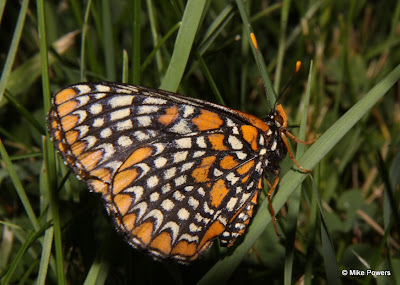Last Sunday Reina and I spent a huge amount of time outdoors, ignoring many of the various chores that beckoned. That's when we found one of our newly planted cherry trees was under siege by no less than forty beetles. To put that in context, this tree only has about twenty leaves. We then noticed many of the plants in our various gardens were hosting "JBs". We found our afternoon mission: eliminate JBs from our yard.
 I wondered if I should turn a hose on these Japanese Beetles before
I wondered if I should turn a hose on these Japanese Beetles beforecollecting them. I decided to let them have one last fling.
We set up the standard pheromone-and-bag traps, a solution that may or may not be the gardener-landscaper's best friend. On the plus side, everyone agrees they work brilliantly to attract all JBs in the neighborhood and beyond. On the down side, several would-be-trappers noted many of the beetles never make it into the trap. Instead, they're rumored to take up residence nearby, skeletonizing the very plants you were trying to save. Instead of reducing the population you've swelled it to immeasurable numbers.
 We watched a pair of Song Sparrows collecting insects to feed their young.
We watched a pair of Song Sparrows collecting insects to feed their young.Sadly, JBs are not a food source. I'm not sure what this one is holding.
In our experience the traps work extremely well. Each year we find the bags fill quickly and we note a huge, though never scientifically demonstrated, decrease in JB numbers in the yard. This year we couldn't sit idly by while our plants were suffering such an extreme bout of herbivory. We each grabbed a jar and headed for the garden. We were determined to collect as many as we could.
That's when we noticed the silvery outline of the black JB cloud. While capturing hundreds of JBs we discovered a good number of other interesting insects. Here's a showcase of butterflies and moths we found last weekend. I think I've identified most of them, save one. Any help and/or corrections appreciated!
Note: click on an image for larger version.
 A first for our yard: a Black Swallowtail visits our Bee Balm patch.
A first for our yard: a Black Swallowtail visits our Bee Balm patch.I believe it's a female based on the amount of blue on the hind wings.
 A newly-emerged Baltimore Checkerspot, the state insect of Maryland.
A newly-emerged Baltimore Checkerspot, the state insect of Maryland.Wikipedia says they only lay their eggs on the Turtlehead
(Chelone glabra) (source), but I cannot verify that elsewhere. Anyone?
 A side view of the newly-emerged Baltimore Checkerspot.
A side view of the newly-emerged Baltimore Checkerspot.Brock and Kaufman write, "Beautiful, distinctive, unlike any other
eastern butterfly." Hard to find fault with that description!
 A yellow-form female Eastern Tiger Swallowtail. I've noticed a couple similarly
A yellow-form female Eastern Tiger Swallowtail. I've noticed a couple similarlymarked swallowtails this summer, I wonder if they are Canadian Swallowtails.
 A Virginia Ctenucha, the largest and most
A Virginia Ctenucha, the largest and mostbroad-winged wasp moth in North America (source).
 UPDATE: Identified as a Confused Haploa (Haploa confusa).
UPDATE: Identified as a Confused Haploa (Haploa confusa).Thanks, nishiki_85 and Meena!
-



6 comments:
noflickster,
Glad you found some good from one of the CFIA's & USDA's most wanted.
Nice images!
As for the last image, it may be a moth from the family Arctiidae, commonly known as Tiger Moths.
If you have time, enjoy looking through this site.
http://www.cbif.gc.ca/noctuoidea/provinces/onarct_e.php
Bob
Another great way to capture them is to hang light-colored clothes on the clothesline! I always have to do a good shake-out, or they'll hang right on and end up in the house.
Lovely butterfly photos! The swallowtails are so large and colorful, I lust love them.
nishiki_85 - I don't think I could pick a "worst of the worst" invasive species, but JBs are certainly in my top 10 most wanted! In the old days, that is, pre-kid, I would have just grumbled and flailed with the beetles, but in trying to come up with some fun and interesting things to do we discovered a whole new world amongst our plants. And beetles.
And thanks for the link! I got confirmation that my unidentified moth is Haploa confusa - the spread wing image looks different than the folded wings of my moth, but a google image search showed some very similar specimens.
Here's another useful link: North American Moth Photographers Group.
Thanks for your comment!
-Mike
@jan_m - we've been lucky in not bringing them in with the laundry, maybe our traps are luring them away! We noticed very full JB traps at a blueberry farm last week and in the 90 minutes we were there only two on plants.
We'll keep an eye on our laundry, thanks for the tip!
-Mike
@Amber_Coakley - Thanks! Last summer we were rewarded with Spicebush Swallowtails using our spicebush, part of our native plant garden. We haven't seen them yet this year, but we're watching!
-Mike
Post a Comment